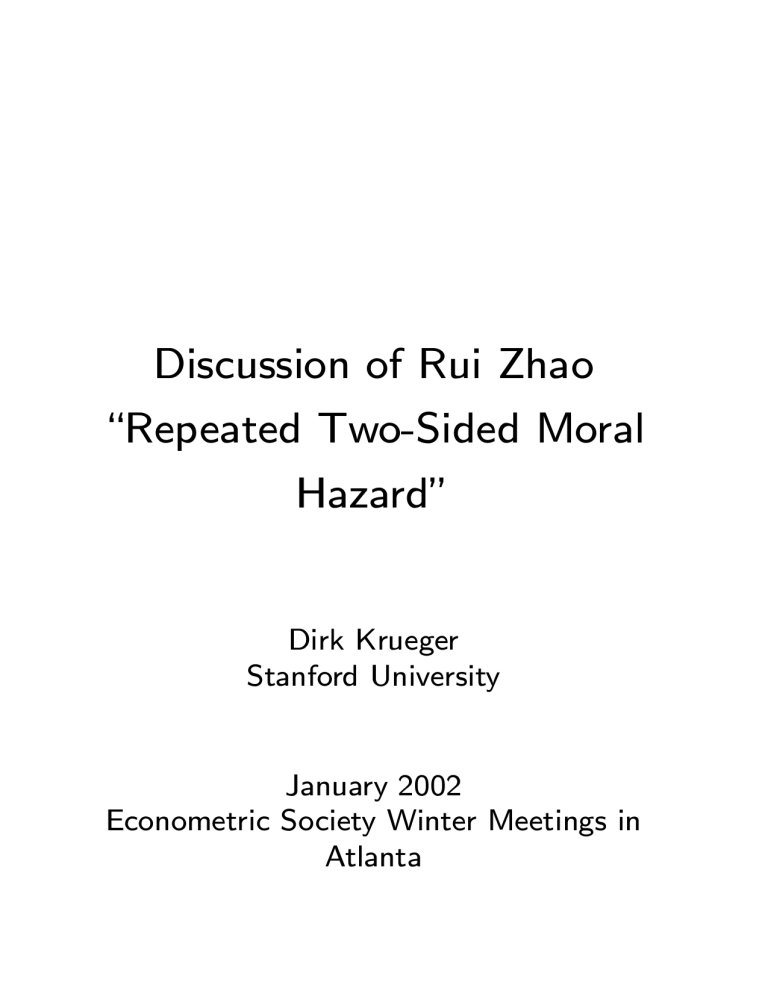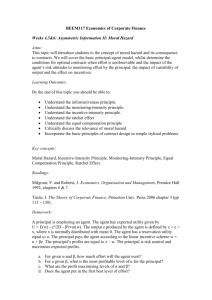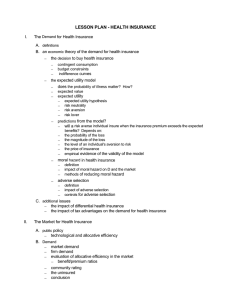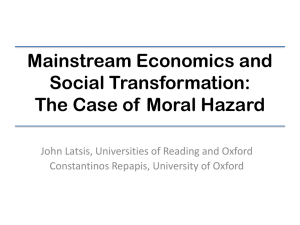Discussion of Rui Zhao \Repeated Two-Sided Moral Hazard" Dirk Krueger

Discussion of Rui Zhao
\Repeated Two-Sided Moral
Hazard"
Dirk Krueger
Stanford University
January 2002
Econometric Society Winter Meetings in
Atlanta
MAIN RESULTS
1. Under fairly general conditions Pareto optimal contracts under repeated two-sided moral hazard are recursive
2. Partial characterization of optimal contracts
3. Obvious next step: explore further properties of optimal contracts using numerical \examples"
MAIN ASSUMPTIONS
1. For all µ i
2 £ i
; all a i
2 A i
¼ ( µ i j a i
) > 0
2.
u i
: ( c; 1 ) ! < is strictly concave and lim c !
c
( c ) = ¡1
3. There exist a i
; a
0 i
2 A i such that g i
( a i
) = g i
( a
0 i
)
4. (In¯nite horizon)
RECURSIVE FORMULATION
² State variable
U : promise of expected discounted lifetime utility for agent 1
² Control Variables:
® i
: probability distribution over e®ort a i
2 A i c i
( µ ) : consumption, conditional on public signal
µ 2 £
1
£ £
2
U ( µ ) : continuation utility of agent 1, conditional on µ
² Timing
Pick efforts
?
i
Draw
?
=(
?
,
?
)
1 2
Output x(
?
) realized
Pick cons. c (
?
), U(
?
)
i
Come in with U with
?
~
?
(
?
|
?
)
i i i
Come in with U’=U(
?
)
Today Tomorrow Time
Figure 1:
² Bellman equation
=
V ( U )
® i
;c i max
( µ ) ;U ( µ )
X
µ
1
2 £
1
X
µ
2
2 £
2
¼
1
( µ
1 j ®
1
) ¼ f u
2
( c
2
( µ )) + ±V ( U ( µ )) ¡ g
2
( ®
2
) g
2
( µ
2 j ®
2
) ¤ subject to
{ Promise Keeping
U =
X X
¼
1
( µ
1 j ®
1
) ¼
2
( µ
2 j ®
2
) ¤
µ
1
2 £
1
µ
2
2 £
2 f u
1
( c
1
( µ )) + ±U ( µ ) ¡ g
1
( ®
1
) g
{ IC, agent 1: for all
¸ a
1
2 A
1
X X
¼
1
( µ
1 j ®
1
) ¼
2
( µ
2 j ®
2
) ¤
µ
1
2 £
1
µ
2
2 £
2 f u
1
( c
1
( µ )) +
X
¼
±U
1
( µ
(
1
µ ) ¡ j a
1
) ¼ g
2
1
(
( µ
®
1
) g
2 j ®
2
) ¤
µ
1
2 £
1
µ
2
2 £
2 f u
1
( c
1
( µ )) + ±U ( µ ) ¡ g
1
( a
1
) g
{ IC for agent 2: for all
¸ a
2
2 A
2
X X
¼
1
( µ
1 j ®
1
) ¼
2
( µ
2 j ®
2
) ¤
µ
1
2 £
1
µ
2
2 £
2 f u
2
( c
2
( µ )) +
X
¼
±V
1
(
( µ
1
U ( µ )) j ®
1
) ¼
2
¡
( µ g
2
2
( ®
2
) j a
2
) ¤ g
µ
1
2 £
1
µ
2
2 £
2 f u
2
( c
2
( µ )) + ±V ( U ( µ )) g ¡ g
2
( a
2
)
{ Resource Feasibility: for all µ 2 £
1
£ £
2 c
1
( µ ) + c
2
( µ ) = x ( µ )
MAIN CHARACTERIZATION
² Two-Sided Moral Hazard: Sub-martingale result u u
0
2
0
1
( c
( c
1
2
(
(
µ
µ
))
))
=
·
X
µ
0
2
X
µ
0
1
¼ ( µ
0
2 j ®
0
2
)
X
µ
0
2
2
X
¼ ( µ
0
1 j ®
0
1
) u u
0
1
0
2
( c
2
( c
1
( µ
0
))
( µ
0 ))
3
¡ 1
µ
0
1
¼ ( µ
0
2 j ®
0
2
) ¼ ( µ
0
1 j ®
0
1
) u
0 u
0
1
2
( c
1
( µ
0
( c
2
( µ
0
))
)) where c i
( µ ) = c i
( U ; µ ) c i
®
0 i
( µ
0
= ®
) = c i
0 i
( U
( U
0
0
) = ®
0 i
; µ
0
) =
( c i
U ( µ ))
( U ( µ ); µ
0
)
² One-Sided Moral Hazard (Rogerson 1985)): Agent
1 is risk neutral principal; agent 2 has moral hazard problem; equal discount factors: Martingale result or
1 u
0
2
( c
2
1 u
0
2
( c
2
( µ ))
( µ ))
=
X
¼ ( µ
0 j ®
0
2
)
"
=
=
µ
0
X
µ
0
E
µ
¼ ( µ
0 j ®
0
2
) u
0
2
(
1
0 j ®
0
2 u
0
2
( c
2 u
(
0
2 c
(
1
2 c
2
1
( µ
( µ
0
))
( µ
0
)
0
))
))
#
¡ 1
MAIN CHARACTERIZATION
² Two-Sided Moral Hazard
2 u
0
1
( c
1 u
0
2
( c
2
( µ ))
( µ ))
=
X
µ
0
2
¼ ( µ
0
2 j ®
0
2
)
X
µ
0
1
¼ ( µ
0
1 j ®
0
1
) u
0
2 u
0
1
( c
2
( µ
( c
1
( µ
0 ))
3
¡ 1
0
)) where c i
( µ ) = c i
( U ; µ ) c i
®
0 i
( µ
0
= ®
) = c i
0 i
( U
( U
0
0
) = ®
0 i
; µ
0
) =
( c i
U ( µ ))
( U ( µ ); µ
0
)
² One-Sided Moral Hazard (Rogerson 1985)): Agent
1 is risk neutral principal; agent 2 has moral hazard problem; equal discount factors or
1 u
0
2
( c
2
1 u
0
2
( c
2
( µ ))
( µ ))
=
X
¼ ( µ
0 j ®
0
2
)
µ
0
(
" u
0
2
( c
2
( µ
0
))
#
¡ 1
1
)
1
= E
µ
0 j ®
0
2 u
0
2
( c
2
( µ
0
))
SMALL REMARKS
² What restrictions does the use of public actions impose?
² Implementation of optimal contracts?
² Connection with observables? Characterization of consumption (compensation) process? Note that the results about long-run behavior still involve endogenous choices.
NUMERICAL EXAMPLES
² Suppose A i
= f a l
; a h g and £ i
= f µ
1
; µ
2 g
² Only one (continuous) state variable U
² 14 control variables
² Potential problem: unbounded domain of U ,
U ( µ )
² Potential resolution: lower bounds on continuation utilities (because of limited commitment)
U ( µ ) ¸ u
1
V ( U ( µ )) ¸ u
2
² But: this may change implications of the model drastically: see Atkeson and Lucas (1992) vs.
(1995)




